Report: Critical Evaluation of Change Management Theories and Models
VerifiedAdded on 2020/01/28
|13
|4119
|113
Report
AI Summary
This report provides a critical evaluation of change management, focusing on theories and models essential for organizational adaptation and survival in a competitive environment. It explores various aspects of change management, emphasizing the need for structured plans aligned with established theories. The report delves into Lewin's, Kotter's, and ADKAR models, analyzing their significance and application in real-world scenarios. Case studies of BBC and DEI airlines are used to illustrate the practical implications of these models, highlighting the consequences of failing to adapt to change. The analysis underscores the importance of effective implementation strategies, considering both internal and external factors. The report also examines issues in change management, discussing the challenges and potential failures associated with various approaches. It emphasizes the need for a planned and open-ended approach to change, allowing for flexibility and learning. The report highlights the importance of stakeholder acceptance and the need for managers to prioritize their interests during the change process. Overall, the report provides a comprehensive overview of change management, offering insights into the critical evaluation of theories, models, and their practical application within organizations.
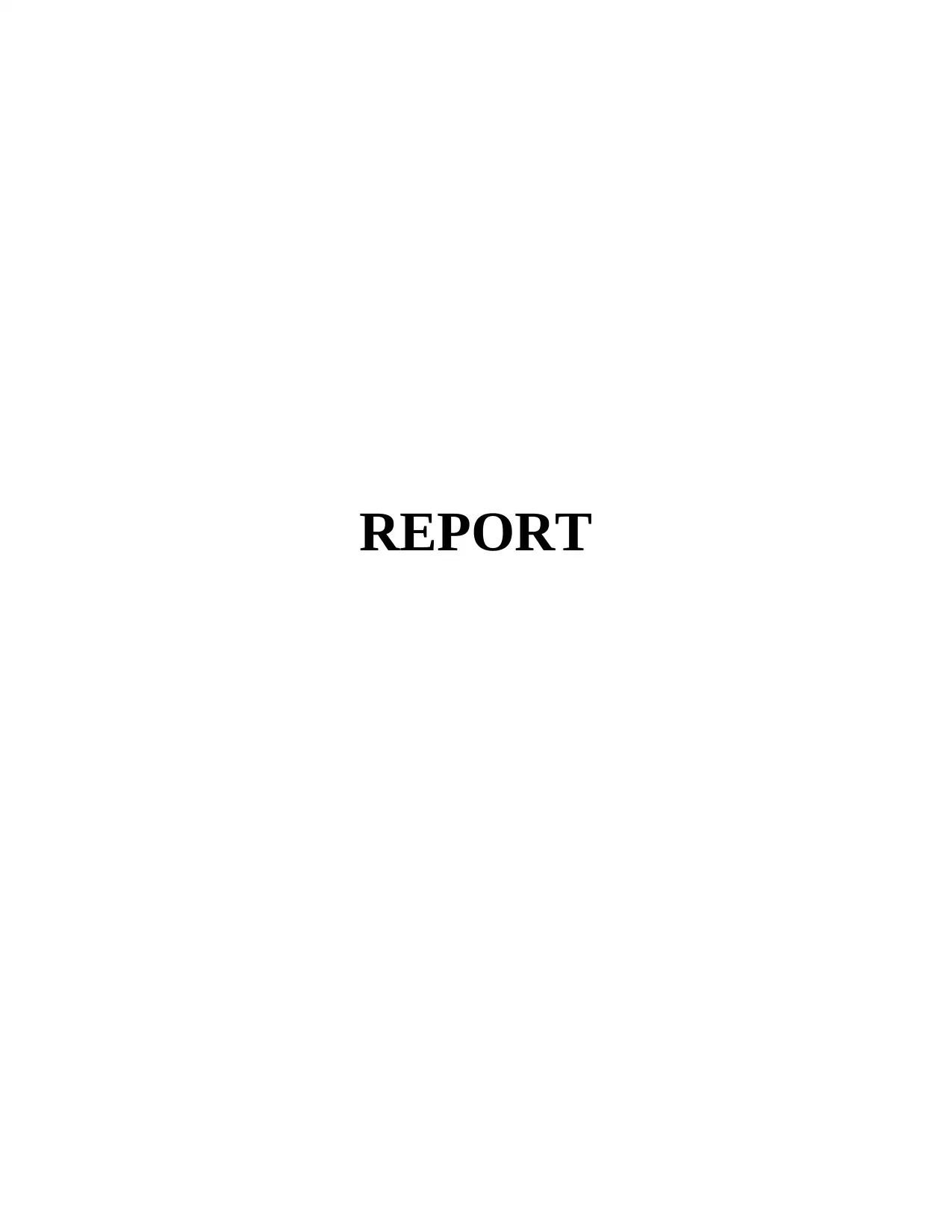
REPORT
Paraphrase This Document
Need a fresh take? Get an instant paraphrase of this document with our AI Paraphraser
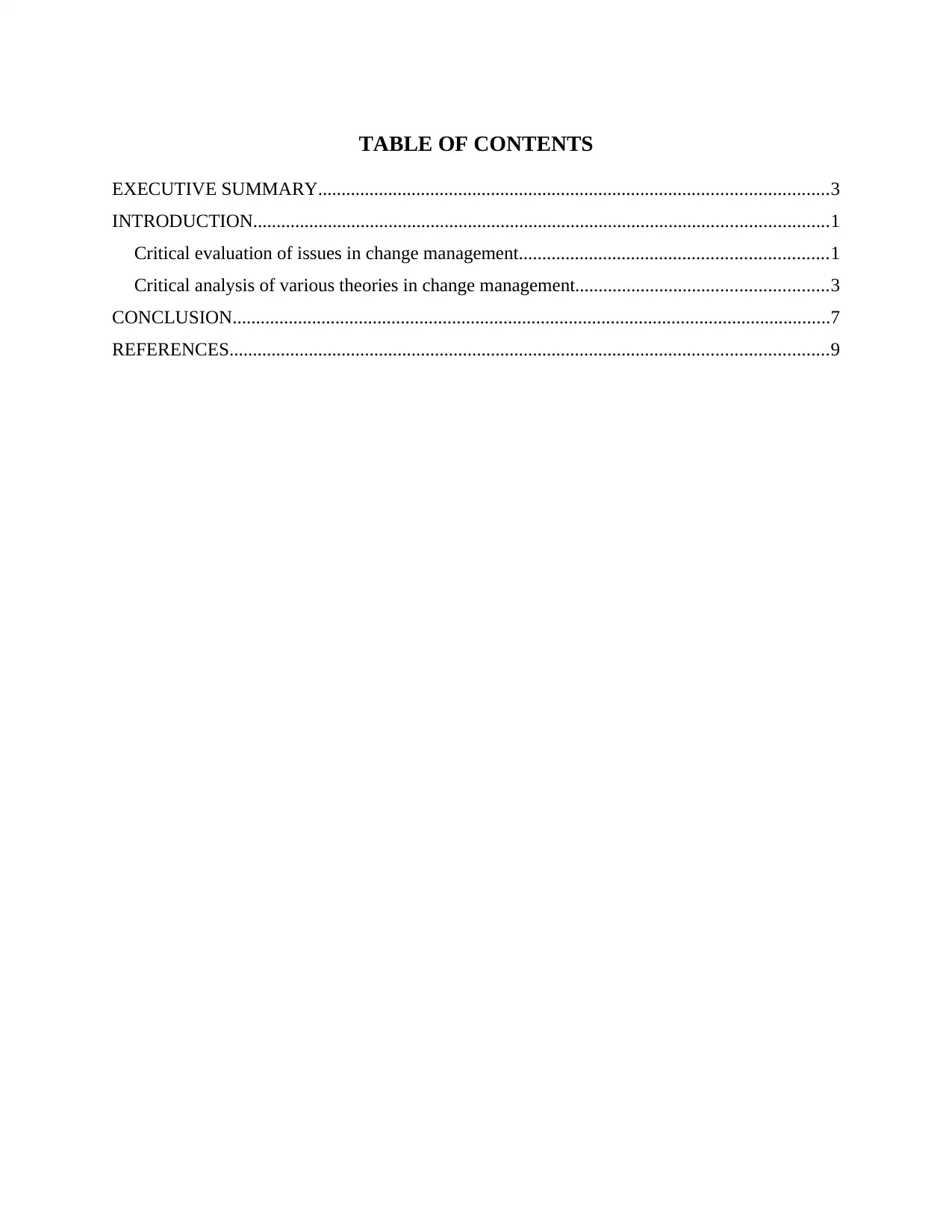
TABLE OF CONTENTS
EXECUTIVE SUMMARY.............................................................................................................3
INTRODUCTION...........................................................................................................................1
Critical evaluation of issues in change management..................................................................1
Critical analysis of various theories in change management......................................................3
CONCLUSION................................................................................................................................7
REFERENCES................................................................................................................................9
EXECUTIVE SUMMARY.............................................................................................................3
INTRODUCTION...........................................................................................................................1
Critical evaluation of issues in change management..................................................................1
Critical analysis of various theories in change management......................................................3
CONCLUSION................................................................................................................................7
REFERENCES................................................................................................................................9
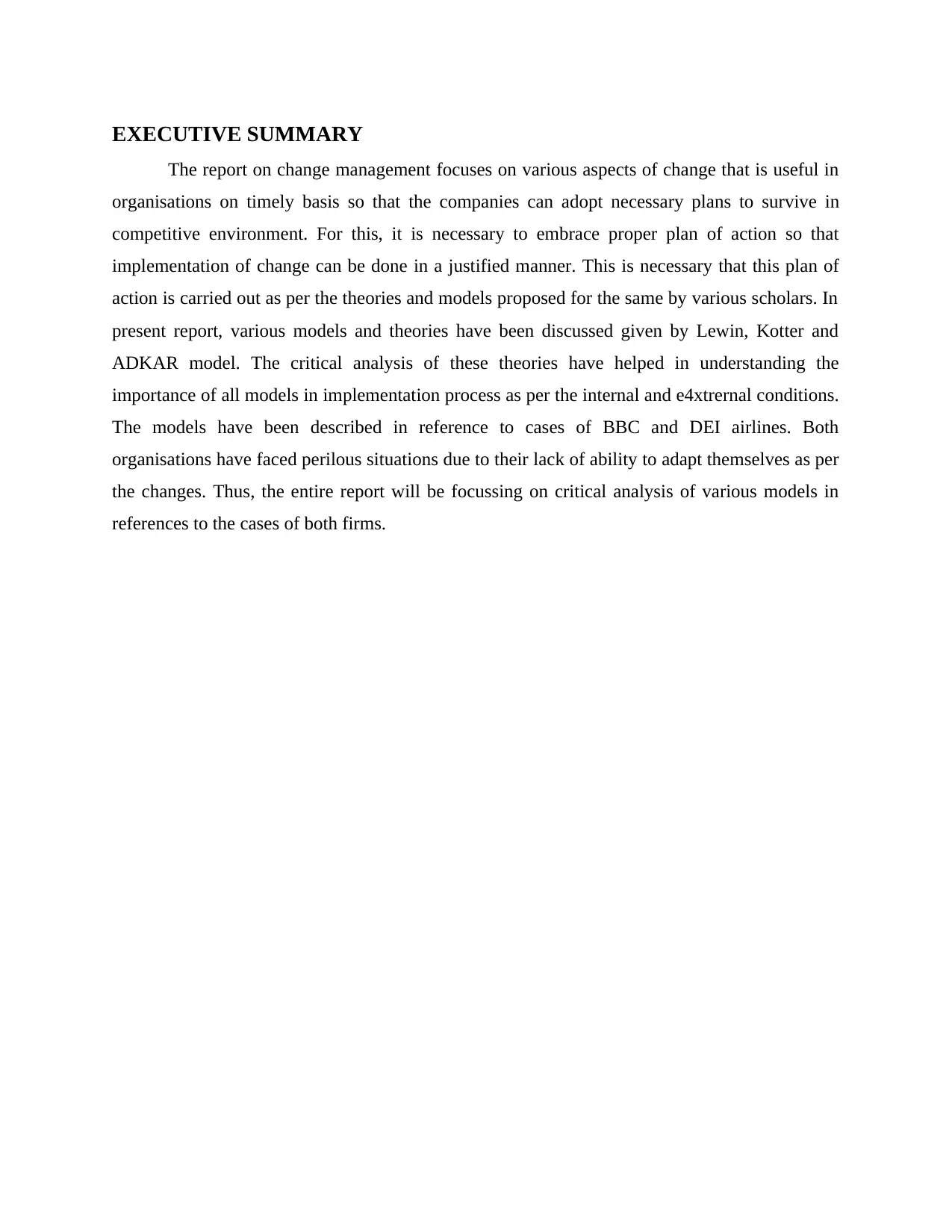
EXECUTIVE SUMMARY
The report on change management focuses on various aspects of change that is useful in
organisations on timely basis so that the companies can adopt necessary plans to survive in
competitive environment. For this, it is necessary to embrace proper plan of action so that
implementation of change can be done in a justified manner. This is necessary that this plan of
action is carried out as per the theories and models proposed for the same by various scholars. In
present report, various models and theories have been discussed given by Lewin, Kotter and
ADKAR model. The critical analysis of these theories have helped in understanding the
importance of all models in implementation process as per the internal and e4xtrernal conditions.
The models have been described in reference to cases of BBC and DEI airlines. Both
organisations have faced perilous situations due to their lack of ability to adapt themselves as per
the changes. Thus, the entire report will be focussing on critical analysis of various models in
references to the cases of both firms.
The report on change management focuses on various aspects of change that is useful in
organisations on timely basis so that the companies can adopt necessary plans to survive in
competitive environment. For this, it is necessary to embrace proper plan of action so that
implementation of change can be done in a justified manner. This is necessary that this plan of
action is carried out as per the theories and models proposed for the same by various scholars. In
present report, various models and theories have been discussed given by Lewin, Kotter and
ADKAR model. The critical analysis of these theories have helped in understanding the
importance of all models in implementation process as per the internal and e4xtrernal conditions.
The models have been described in reference to cases of BBC and DEI airlines. Both
organisations have faced perilous situations due to their lack of ability to adapt themselves as per
the changes. Thus, the entire report will be focussing on critical analysis of various models in
references to the cases of both firms.
⊘ This is a preview!⊘
Do you want full access?
Subscribe today to unlock all pages.

Trusted by 1+ million students worldwide

Paraphrase This Document
Need a fresh take? Get an instant paraphrase of this document with our AI Paraphraser
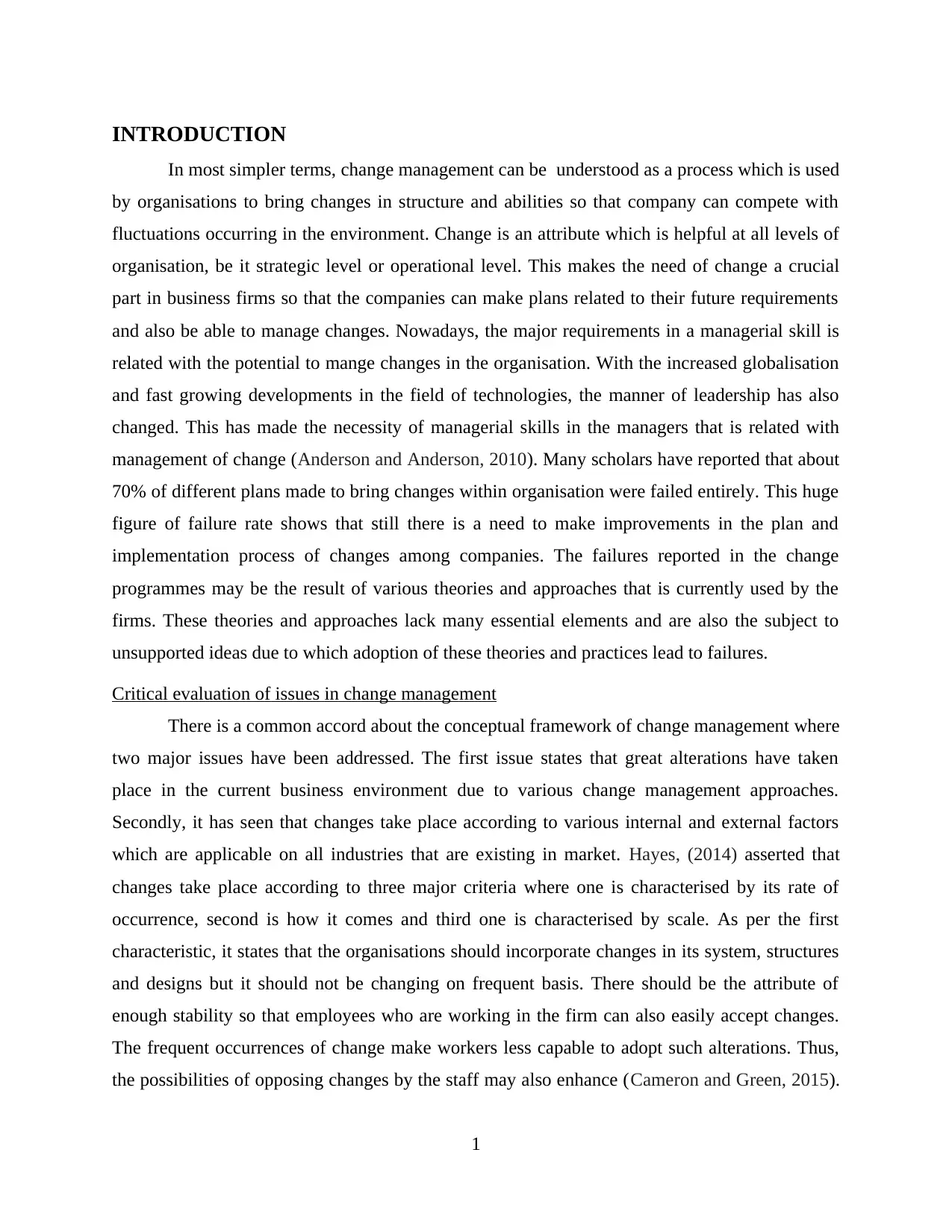
INTRODUCTION
In most simpler terms, change management can be understood as a process which is used
by organisations to bring changes in structure and abilities so that company can compete with
fluctuations occurring in the environment. Change is an attribute which is helpful at all levels of
organisation, be it strategic level or operational level. This makes the need of change a crucial
part in business firms so that the companies can make plans related to their future requirements
and also be able to manage changes. Nowadays, the major requirements in a managerial skill is
related with the potential to mange changes in the organisation. With the increased globalisation
and fast growing developments in the field of technologies, the manner of leadership has also
changed. This has made the necessity of managerial skills in the managers that is related with
management of change (Anderson and Anderson, 2010). Many scholars have reported that about
70% of different plans made to bring changes within organisation were failed entirely. This huge
figure of failure rate shows that still there is a need to make improvements in the plan and
implementation process of changes among companies. The failures reported in the change
programmes may be the result of various theories and approaches that is currently used by the
firms. These theories and approaches lack many essential elements and are also the subject to
unsupported ideas due to which adoption of these theories and practices lead to failures.
Critical evaluation of issues in change management
There is a common accord about the conceptual framework of change management where
two major issues have been addressed. The first issue states that great alterations have taken
place in the current business environment due to various change management approaches.
Secondly, it has seen that changes take place according to various internal and external factors
which are applicable on all industries that are existing in market. Hayes, (2014) asserted that
changes take place according to three major criteria where one is characterised by its rate of
occurrence, second is how it comes and third one is characterised by scale. As per the first
characteristic, it states that the organisations should incorporate changes in its system, structures
and designs but it should not be changing on frequent basis. There should be the attribute of
enough stability so that employees who are working in the firm can also easily accept changes.
The frequent occurrences of change make workers less capable to adopt such alterations. Thus,
the possibilities of opposing changes by the staff may also enhance (Cameron and Green, 2015).
1
In most simpler terms, change management can be understood as a process which is used
by organisations to bring changes in structure and abilities so that company can compete with
fluctuations occurring in the environment. Change is an attribute which is helpful at all levels of
organisation, be it strategic level or operational level. This makes the need of change a crucial
part in business firms so that the companies can make plans related to their future requirements
and also be able to manage changes. Nowadays, the major requirements in a managerial skill is
related with the potential to mange changes in the organisation. With the increased globalisation
and fast growing developments in the field of technologies, the manner of leadership has also
changed. This has made the necessity of managerial skills in the managers that is related with
management of change (Anderson and Anderson, 2010). Many scholars have reported that about
70% of different plans made to bring changes within organisation were failed entirely. This huge
figure of failure rate shows that still there is a need to make improvements in the plan and
implementation process of changes among companies. The failures reported in the change
programmes may be the result of various theories and approaches that is currently used by the
firms. These theories and approaches lack many essential elements and are also the subject to
unsupported ideas due to which adoption of these theories and practices lead to failures.
Critical evaluation of issues in change management
There is a common accord about the conceptual framework of change management where
two major issues have been addressed. The first issue states that great alterations have taken
place in the current business environment due to various change management approaches.
Secondly, it has seen that changes take place according to various internal and external factors
which are applicable on all industries that are existing in market. Hayes, (2014) asserted that
changes take place according to three major criteria where one is characterised by its rate of
occurrence, second is how it comes and third one is characterised by scale. As per the first
characteristic, it states that the organisations should incorporate changes in its system, structures
and designs but it should not be changing on frequent basis. There should be the attribute of
enough stability so that employees who are working in the firm can also easily accept changes.
The frequent occurrences of change make workers less capable to adopt such alterations. Thus,
the possibilities of opposing changes by the staff may also enhance (Cameron and Green, 2015).
1
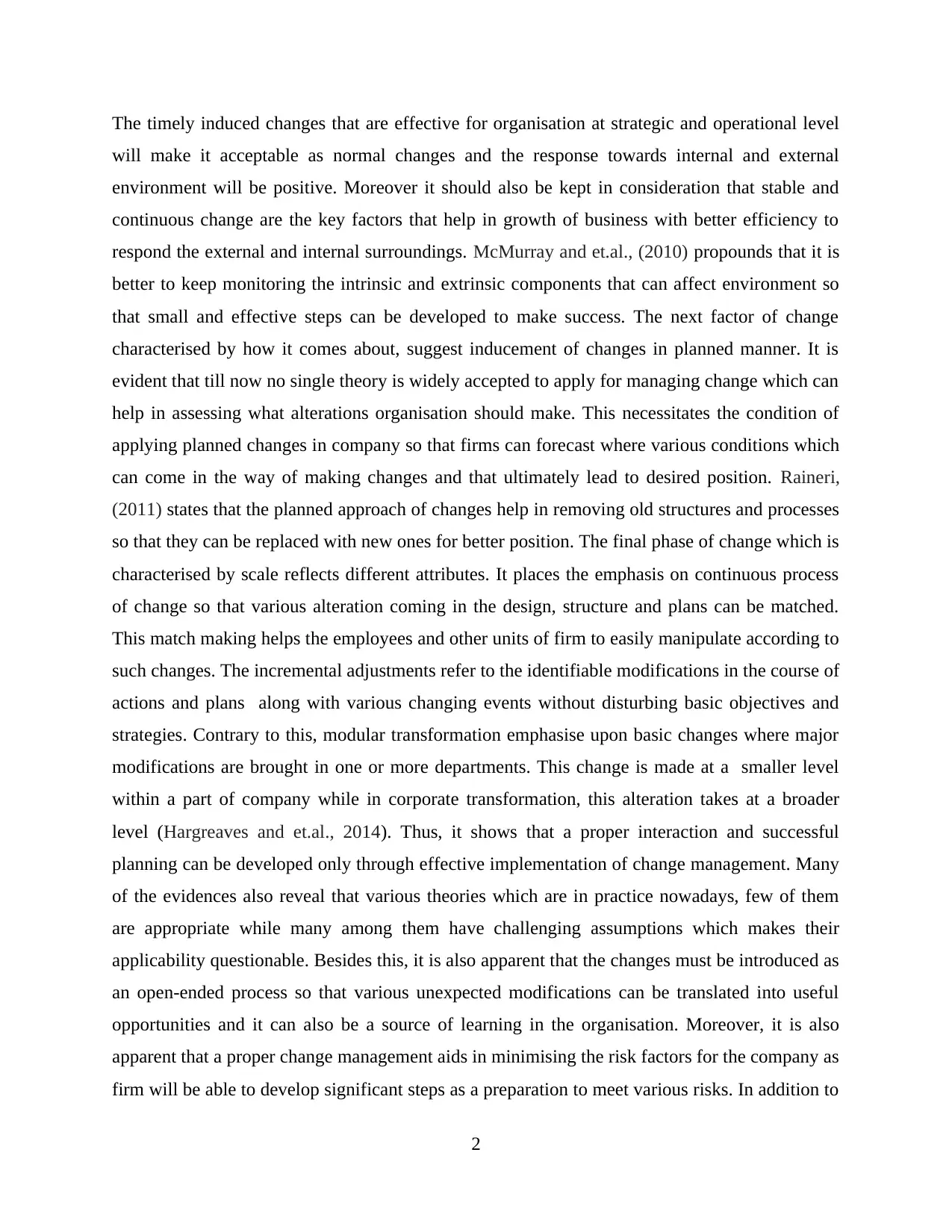
The timely induced changes that are effective for organisation at strategic and operational level
will make it acceptable as normal changes and the response towards internal and external
environment will be positive. Moreover it should also be kept in consideration that stable and
continuous change are the key factors that help in growth of business with better efficiency to
respond the external and internal surroundings. McMurray and et.al., (2010) propounds that it is
better to keep monitoring the intrinsic and extrinsic components that can affect environment so
that small and effective steps can be developed to make success. The next factor of change
characterised by how it comes about, suggest inducement of changes in planned manner. It is
evident that till now no single theory is widely accepted to apply for managing change which can
help in assessing what alterations organisation should make. This necessitates the condition of
applying planned changes in company so that firms can forecast where various conditions which
can come in the way of making changes and that ultimately lead to desired position. Raineri,
(2011) states that the planned approach of changes help in removing old structures and processes
so that they can be replaced with new ones for better position. The final phase of change which is
characterised by scale reflects different attributes. It places the emphasis on continuous process
of change so that various alteration coming in the design, structure and plans can be matched.
This match making helps the employees and other units of firm to easily manipulate according to
such changes. The incremental adjustments refer to the identifiable modifications in the course of
actions and plans along with various changing events without disturbing basic objectives and
strategies. Contrary to this, modular transformation emphasise upon basic changes where major
modifications are brought in one or more departments. This change is made at a smaller level
within a part of company while in corporate transformation, this alteration takes at a broader
level (Hargreaves and et.al., 2014). Thus, it shows that a proper interaction and successful
planning can be developed only through effective implementation of change management. Many
of the evidences also reveal that various theories which are in practice nowadays, few of them
are appropriate while many among them have challenging assumptions which makes their
applicability questionable. Besides this, it is also apparent that the changes must be introduced as
an open-ended process so that various unexpected modifications can be translated into useful
opportunities and it can also be a source of learning in the organisation. Moreover, it is also
apparent that a proper change management aids in minimising the risk factors for the company as
firm will be able to develop significant steps as a preparation to meet various risks. In addition to
2
will make it acceptable as normal changes and the response towards internal and external
environment will be positive. Moreover it should also be kept in consideration that stable and
continuous change are the key factors that help in growth of business with better efficiency to
respond the external and internal surroundings. McMurray and et.al., (2010) propounds that it is
better to keep monitoring the intrinsic and extrinsic components that can affect environment so
that small and effective steps can be developed to make success. The next factor of change
characterised by how it comes about, suggest inducement of changes in planned manner. It is
evident that till now no single theory is widely accepted to apply for managing change which can
help in assessing what alterations organisation should make. This necessitates the condition of
applying planned changes in company so that firms can forecast where various conditions which
can come in the way of making changes and that ultimately lead to desired position. Raineri,
(2011) states that the planned approach of changes help in removing old structures and processes
so that they can be replaced with new ones for better position. The final phase of change which is
characterised by scale reflects different attributes. It places the emphasis on continuous process
of change so that various alteration coming in the design, structure and plans can be matched.
This match making helps the employees and other units of firm to easily manipulate according to
such changes. The incremental adjustments refer to the identifiable modifications in the course of
actions and plans along with various changing events without disturbing basic objectives and
strategies. Contrary to this, modular transformation emphasise upon basic changes where major
modifications are brought in one or more departments. This change is made at a smaller level
within a part of company while in corporate transformation, this alteration takes at a broader
level (Hargreaves and et.al., 2014). Thus, it shows that a proper interaction and successful
planning can be developed only through effective implementation of change management. Many
of the evidences also reveal that various theories which are in practice nowadays, few of them
are appropriate while many among them have challenging assumptions which makes their
applicability questionable. Besides this, it is also apparent that the changes must be introduced as
an open-ended process so that various unexpected modifications can be translated into useful
opportunities and it can also be a source of learning in the organisation. Moreover, it is also
apparent that a proper change management aids in minimising the risk factors for the company as
firm will be able to develop significant steps as a preparation to meet various risks. In addition to
2
⊘ This is a preview!⊘
Do you want full access?
Subscribe today to unlock all pages.

Trusted by 1+ million students worldwide
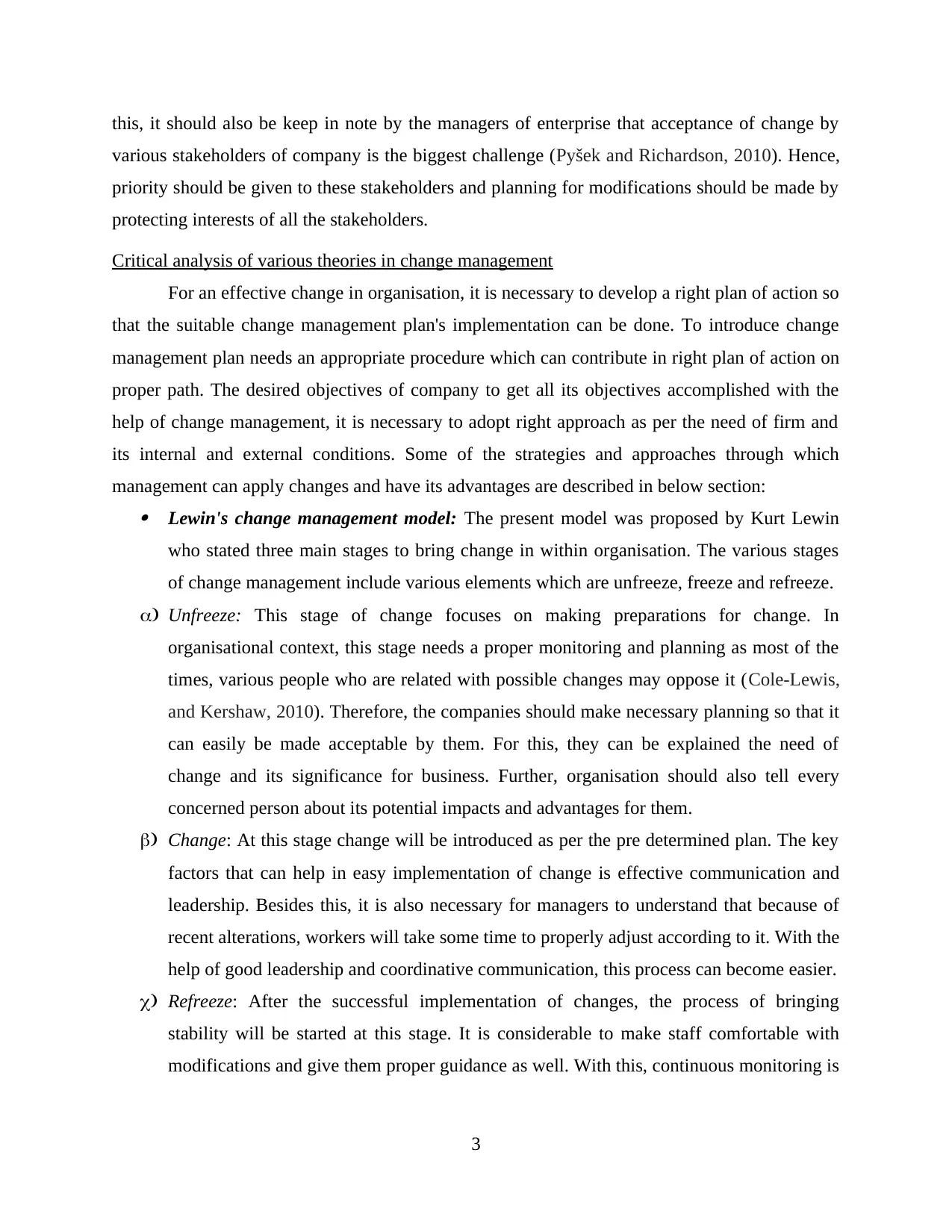
this, it should also be keep in note by the managers of enterprise that acceptance of change by
various stakeholders of company is the biggest challenge (Pyšek and Richardson, 2010). Hence,
priority should be given to these stakeholders and planning for modifications should be made by
protecting interests of all the stakeholders.
Critical analysis of various theories in change management
For an effective change in organisation, it is necessary to develop a right plan of action so
that the suitable change management plan's implementation can be done. To introduce change
management plan needs an appropriate procedure which can contribute in right plan of action on
proper path. The desired objectives of company to get all its objectives accomplished with the
help of change management, it is necessary to adopt right approach as per the need of firm and
its internal and external conditions. Some of the strategies and approaches through which
management can apply changes and have its advantages are described in below section: Lewin's change management model: The present model was proposed by Kurt Lewin
who stated three main stages to bring change in within organisation. The various stages
of change management include various elements which are unfreeze, freeze and refreeze.
a) Unfreeze: This stage of change focuses on making preparations for change. In
organisational context, this stage needs a proper monitoring and planning as most of the
times, various people who are related with possible changes may oppose it (Cole-Lewis,
and Kershaw, 2010). Therefore, the companies should make necessary planning so that it
can easily be made acceptable by them. For this, they can be explained the need of
change and its significance for business. Further, organisation should also tell every
concerned person about its potential impacts and advantages for them.
b) Change: At this stage change will be introduced as per the pre determined plan. The key
factors that can help in easy implementation of change is effective communication and
leadership. Besides this, it is also necessary for managers to understand that because of
recent alterations, workers will take some time to properly adjust according to it. With the
help of good leadership and coordinative communication, this process can become easier.
c) Refreeze: After the successful implementation of changes, the process of bringing
stability will be started at this stage. It is considerable to make staff comfortable with
modifications and give them proper guidance as well. With this, continuous monitoring is
3
various stakeholders of company is the biggest challenge (Pyšek and Richardson, 2010). Hence,
priority should be given to these stakeholders and planning for modifications should be made by
protecting interests of all the stakeholders.
Critical analysis of various theories in change management
For an effective change in organisation, it is necessary to develop a right plan of action so
that the suitable change management plan's implementation can be done. To introduce change
management plan needs an appropriate procedure which can contribute in right plan of action on
proper path. The desired objectives of company to get all its objectives accomplished with the
help of change management, it is necessary to adopt right approach as per the need of firm and
its internal and external conditions. Some of the strategies and approaches through which
management can apply changes and have its advantages are described in below section: Lewin's change management model: The present model was proposed by Kurt Lewin
who stated three main stages to bring change in within organisation. The various stages
of change management include various elements which are unfreeze, freeze and refreeze.
a) Unfreeze: This stage of change focuses on making preparations for change. In
organisational context, this stage needs a proper monitoring and planning as most of the
times, various people who are related with possible changes may oppose it (Cole-Lewis,
and Kershaw, 2010). Therefore, the companies should make necessary planning so that it
can easily be made acceptable by them. For this, they can be explained the need of
change and its significance for business. Further, organisation should also tell every
concerned person about its potential impacts and advantages for them.
b) Change: At this stage change will be introduced as per the pre determined plan. The key
factors that can help in easy implementation of change is effective communication and
leadership. Besides this, it is also necessary for managers to understand that because of
recent alterations, workers will take some time to properly adjust according to it. With the
help of good leadership and coordinative communication, this process can become easier.
c) Refreeze: After the successful implementation of changes, the process of bringing
stability will be started at this stage. It is considerable to make staff comfortable with
modifications and give them proper guidance as well. With this, continuous monitoring is
3
Paraphrase This Document
Need a fresh take? Get an instant paraphrase of this document with our AI Paraphraser
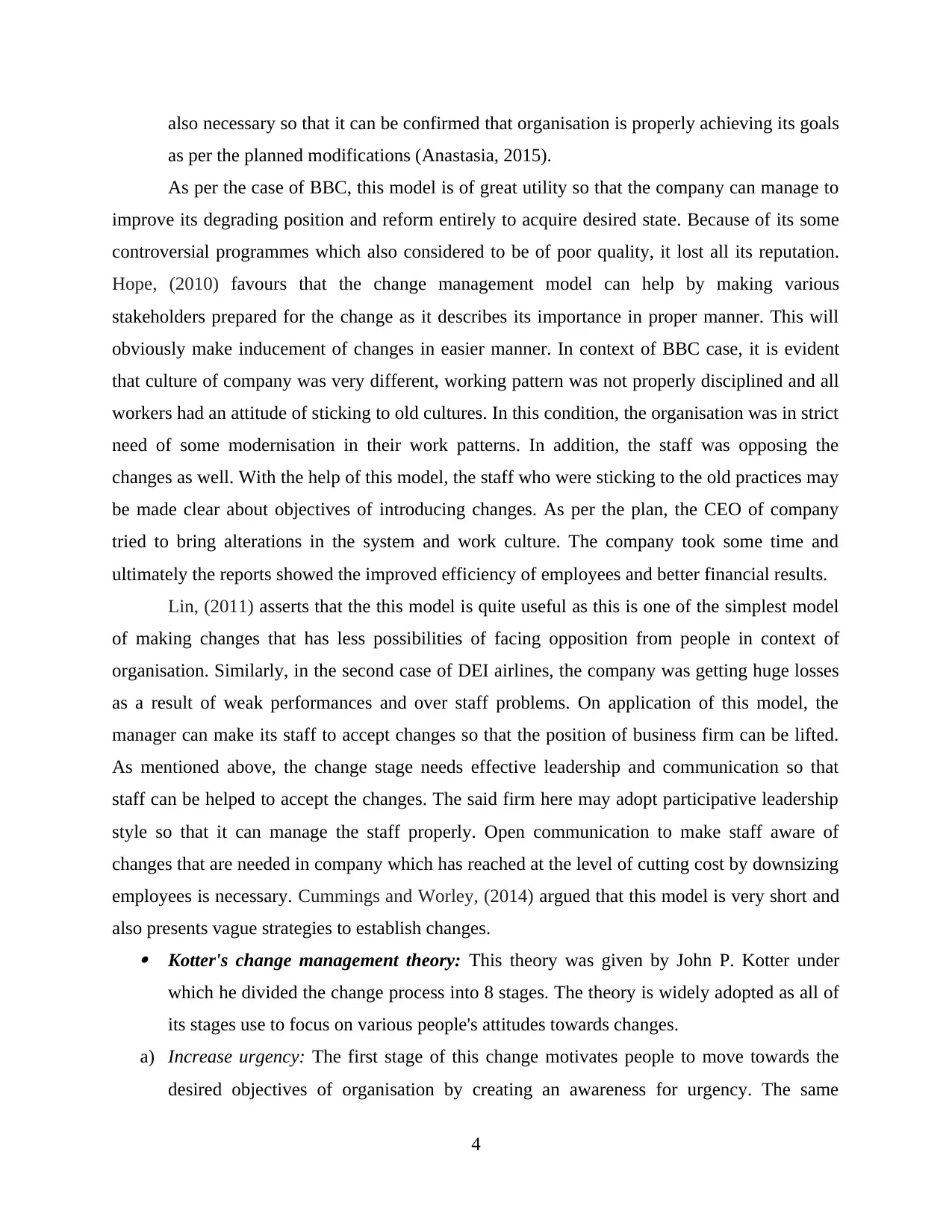
also necessary so that it can be confirmed that organisation is properly achieving its goals
as per the planned modifications (Anastasia, 2015).
As per the case of BBC, this model is of great utility so that the company can manage to
improve its degrading position and reform entirely to acquire desired state. Because of its some
controversial programmes which also considered to be of poor quality, it lost all its reputation.
Hope, (2010) favours that the change management model can help by making various
stakeholders prepared for the change as it describes its importance in proper manner. This will
obviously make inducement of changes in easier manner. In context of BBC case, it is evident
that culture of company was very different, working pattern was not properly disciplined and all
workers had an attitude of sticking to old cultures. In this condition, the organisation was in strict
need of some modernisation in their work patterns. In addition, the staff was opposing the
changes as well. With the help of this model, the staff who were sticking to the old practices may
be made clear about objectives of introducing changes. As per the plan, the CEO of company
tried to bring alterations in the system and work culture. The company took some time and
ultimately the reports showed the improved efficiency of employees and better financial results.
Lin, (2011) asserts that the this model is quite useful as this is one of the simplest model
of making changes that has less possibilities of facing opposition from people in context of
organisation. Similarly, in the second case of DEI airlines, the company was getting huge losses
as a result of weak performances and over staff problems. On application of this model, the
manager can make its staff to accept changes so that the position of business firm can be lifted.
As mentioned above, the change stage needs effective leadership and communication so that
staff can be helped to accept the changes. The said firm here may adopt participative leadership
style so that it can manage the staff properly. Open communication to make staff aware of
changes that are needed in company which has reached at the level of cutting cost by downsizing
employees is necessary. Cummings and Worley, (2014) argued that this model is very short and
also presents vague strategies to establish changes. Kotter's change management theory: This theory was given by John P. Kotter under
which he divided the change process into 8 stages. The theory is widely adopted as all of
its stages use to focus on various people's attitudes towards changes.
a) Increase urgency: The first stage of this change motivates people to move towards the
desired objectives of organisation by creating an awareness for urgency. The same
4
as per the planned modifications (Anastasia, 2015).
As per the case of BBC, this model is of great utility so that the company can manage to
improve its degrading position and reform entirely to acquire desired state. Because of its some
controversial programmes which also considered to be of poor quality, it lost all its reputation.
Hope, (2010) favours that the change management model can help by making various
stakeholders prepared for the change as it describes its importance in proper manner. This will
obviously make inducement of changes in easier manner. In context of BBC case, it is evident
that culture of company was very different, working pattern was not properly disciplined and all
workers had an attitude of sticking to old cultures. In this condition, the organisation was in strict
need of some modernisation in their work patterns. In addition, the staff was opposing the
changes as well. With the help of this model, the staff who were sticking to the old practices may
be made clear about objectives of introducing changes. As per the plan, the CEO of company
tried to bring alterations in the system and work culture. The company took some time and
ultimately the reports showed the improved efficiency of employees and better financial results.
Lin, (2011) asserts that the this model is quite useful as this is one of the simplest model
of making changes that has less possibilities of facing opposition from people in context of
organisation. Similarly, in the second case of DEI airlines, the company was getting huge losses
as a result of weak performances and over staff problems. On application of this model, the
manager can make its staff to accept changes so that the position of business firm can be lifted.
As mentioned above, the change stage needs effective leadership and communication so that
staff can be helped to accept the changes. The said firm here may adopt participative leadership
style so that it can manage the staff properly. Open communication to make staff aware of
changes that are needed in company which has reached at the level of cutting cost by downsizing
employees is necessary. Cummings and Worley, (2014) argued that this model is very short and
also presents vague strategies to establish changes. Kotter's change management theory: This theory was given by John P. Kotter under
which he divided the change process into 8 stages. The theory is widely adopted as all of
its stages use to focus on various people's attitudes towards changes.
a) Increase urgency: The first stage of this change motivates people to move towards the
desired objectives of organisation by creating an awareness for urgency. The same
4
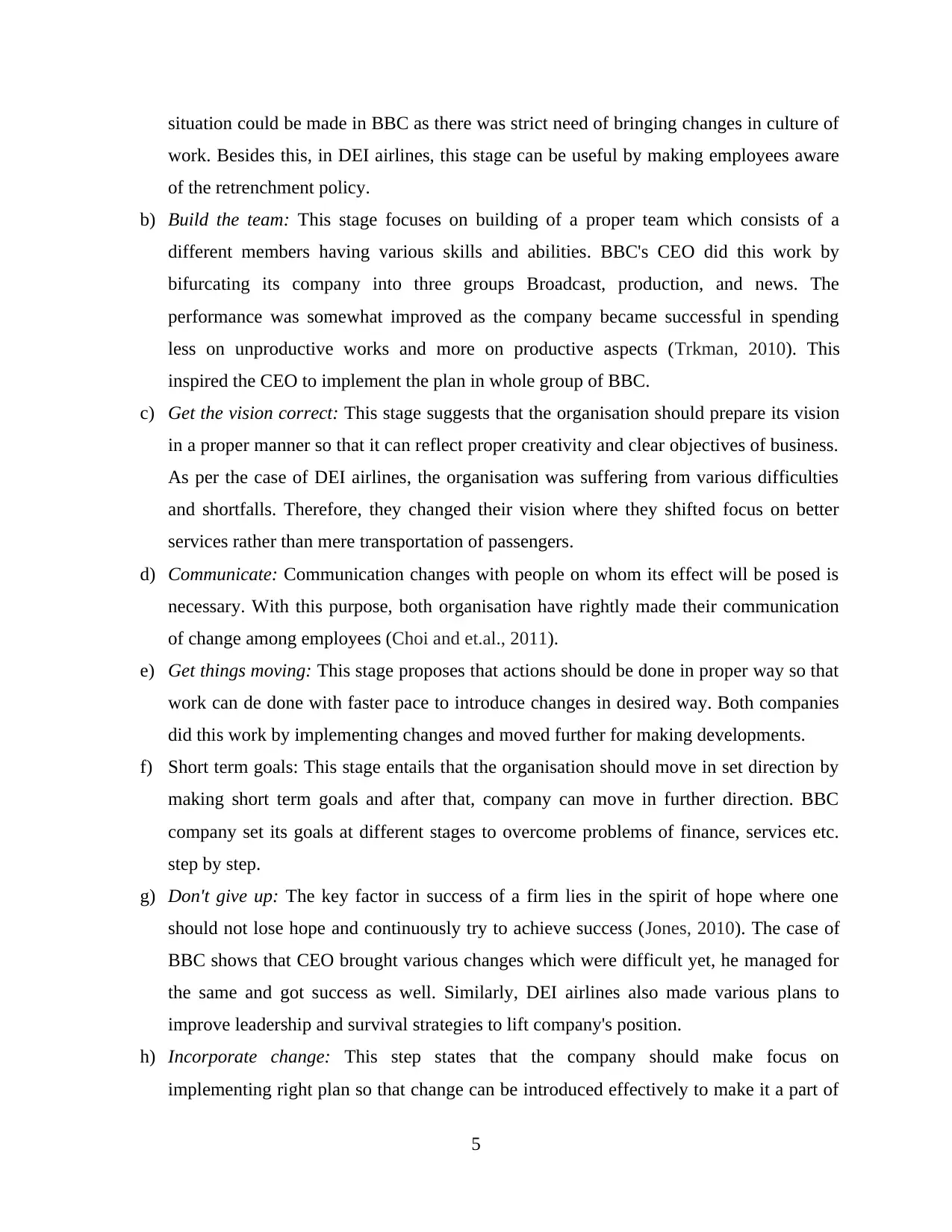
situation could be made in BBC as there was strict need of bringing changes in culture of
work. Besides this, in DEI airlines, this stage can be useful by making employees aware
of the retrenchment policy.
b) Build the team: This stage focuses on building of a proper team which consists of a
different members having various skills and abilities. BBC's CEO did this work by
bifurcating its company into three groups Broadcast, production, and news. The
performance was somewhat improved as the company became successful in spending
less on unproductive works and more on productive aspects (Trkman, 2010). This
inspired the CEO to implement the plan in whole group of BBC.
c) Get the vision correct: This stage suggests that the organisation should prepare its vision
in a proper manner so that it can reflect proper creativity and clear objectives of business.
As per the case of DEI airlines, the organisation was suffering from various difficulties
and shortfalls. Therefore, they changed their vision where they shifted focus on better
services rather than mere transportation of passengers.
d) Communicate: Communication changes with people on whom its effect will be posed is
necessary. With this purpose, both organisation have rightly made their communication
of change among employees (Choi and et.al., 2011).
e) Get things moving: This stage proposes that actions should be done in proper way so that
work can de done with faster pace to introduce changes in desired way. Both companies
did this work by implementing changes and moved further for making developments.
f) Short term goals: This stage entails that the organisation should move in set direction by
making short term goals and after that, company can move in further direction. BBC
company set its goals at different stages to overcome problems of finance, services etc.
step by step.
g) Don't give up: The key factor in success of a firm lies in the spirit of hope where one
should not lose hope and continuously try to achieve success (Jones, 2010). The case of
BBC shows that CEO brought various changes which were difficult yet, he managed for
the same and got success as well. Similarly, DEI airlines also made various plans to
improve leadership and survival strategies to lift company's position.
h) Incorporate change: This step states that the company should make focus on
implementing right plan so that change can be introduced effectively to make it a part of
5
work. Besides this, in DEI airlines, this stage can be useful by making employees aware
of the retrenchment policy.
b) Build the team: This stage focuses on building of a proper team which consists of a
different members having various skills and abilities. BBC's CEO did this work by
bifurcating its company into three groups Broadcast, production, and news. The
performance was somewhat improved as the company became successful in spending
less on unproductive works and more on productive aspects (Trkman, 2010). This
inspired the CEO to implement the plan in whole group of BBC.
c) Get the vision correct: This stage suggests that the organisation should prepare its vision
in a proper manner so that it can reflect proper creativity and clear objectives of business.
As per the case of DEI airlines, the organisation was suffering from various difficulties
and shortfalls. Therefore, they changed their vision where they shifted focus on better
services rather than mere transportation of passengers.
d) Communicate: Communication changes with people on whom its effect will be posed is
necessary. With this purpose, both organisation have rightly made their communication
of change among employees (Choi and et.al., 2011).
e) Get things moving: This stage proposes that actions should be done in proper way so that
work can de done with faster pace to introduce changes in desired way. Both companies
did this work by implementing changes and moved further for making developments.
f) Short term goals: This stage entails that the organisation should move in set direction by
making short term goals and after that, company can move in further direction. BBC
company set its goals at different stages to overcome problems of finance, services etc.
step by step.
g) Don't give up: The key factor in success of a firm lies in the spirit of hope where one
should not lose hope and continuously try to achieve success (Jones, 2010). The case of
BBC shows that CEO brought various changes which were difficult yet, he managed for
the same and got success as well. Similarly, DEI airlines also made various plans to
improve leadership and survival strategies to lift company's position.
h) Incorporate change: This step states that the company should make focus on
implementing right plan so that change can be introduced effectively to make it a part of
5
⊘ This is a preview!⊘
Do you want full access?
Subscribe today to unlock all pages.

Trusted by 1+ million students worldwide
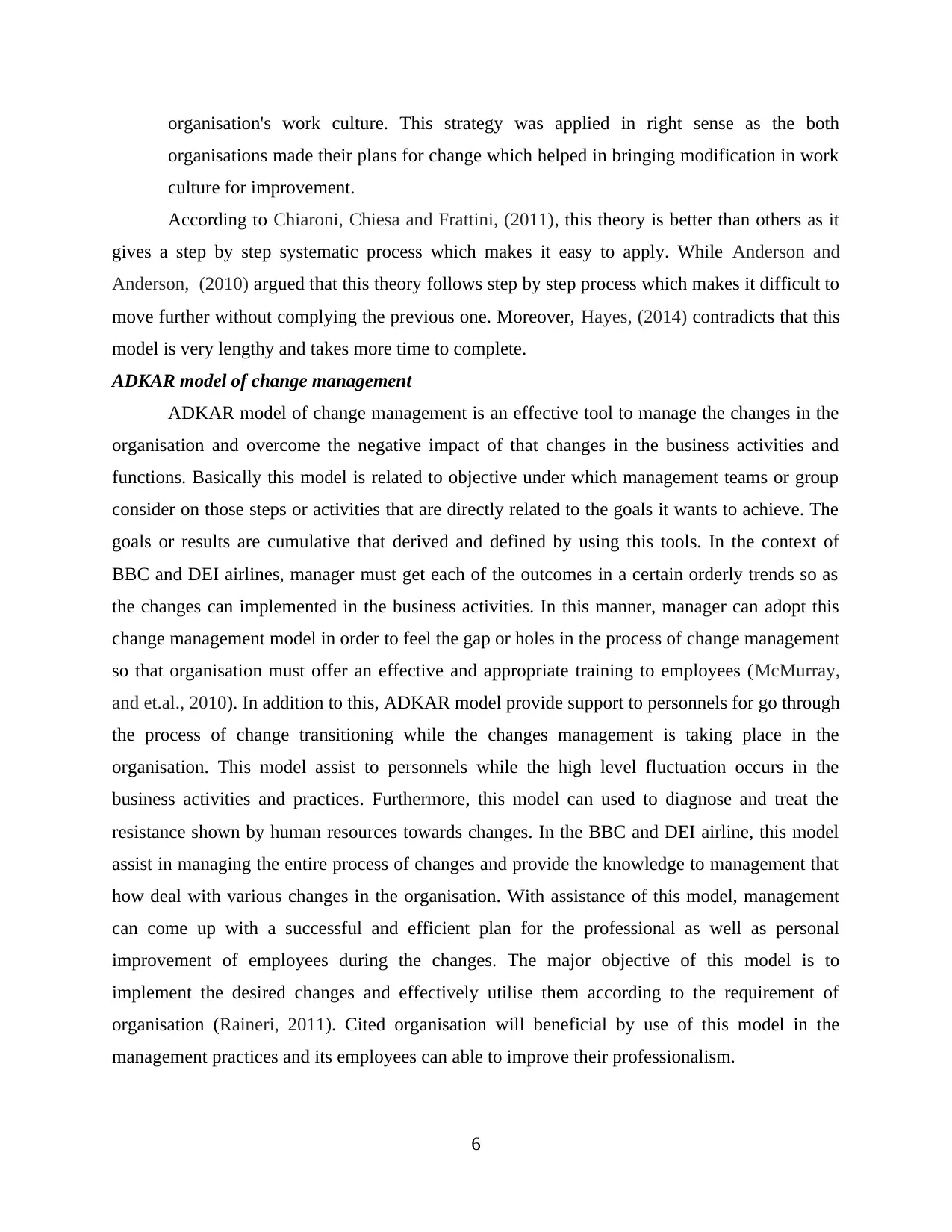
organisation's work culture. This strategy was applied in right sense as the both
organisations made their plans for change which helped in bringing modification in work
culture for improvement.
According to Chiaroni, Chiesa and Frattini, (2011), this theory is better than others as it
gives a step by step systematic process which makes it easy to apply. While Anderson and
Anderson, (2010) argued that this theory follows step by step process which makes it difficult to
move further without complying the previous one. Moreover, Hayes, (2014) contradicts that this
model is very lengthy and takes more time to complete.
ADKAR model of change management
ADKAR model of change management is an effective tool to manage the changes in the
organisation and overcome the negative impact of that changes in the business activities and
functions. Basically this model is related to objective under which management teams or group
consider on those steps or activities that are directly related to the goals it wants to achieve. The
goals or results are cumulative that derived and defined by using this tools. In the context of
BBC and DEI airlines, manager must get each of the outcomes in a certain orderly trends so as
the changes can implemented in the business activities. In this manner, manager can adopt this
change management model in order to feel the gap or holes in the process of change management
so that organisation must offer an effective and appropriate training to employees (McMurray,
and et.al., 2010). In addition to this, ADKAR model provide support to personnels for go through
the process of change transitioning while the changes management is taking place in the
organisation. This model assist to personnels while the high level fluctuation occurs in the
business activities and practices. Furthermore, this model can used to diagnose and treat the
resistance shown by human resources towards changes. In the BBC and DEI airline, this model
assist in managing the entire process of changes and provide the knowledge to management that
how deal with various changes in the organisation. With assistance of this model, management
can come up with a successful and efficient plan for the professional as well as personal
improvement of employees during the changes. The major objective of this model is to
implement the desired changes and effectively utilise them according to the requirement of
organisation (Raineri, 2011). Cited organisation will beneficial by use of this model in the
management practices and its employees can able to improve their professionalism.
6
organisations made their plans for change which helped in bringing modification in work
culture for improvement.
According to Chiaroni, Chiesa and Frattini, (2011), this theory is better than others as it
gives a step by step systematic process which makes it easy to apply. While Anderson and
Anderson, (2010) argued that this theory follows step by step process which makes it difficult to
move further without complying the previous one. Moreover, Hayes, (2014) contradicts that this
model is very lengthy and takes more time to complete.
ADKAR model of change management
ADKAR model of change management is an effective tool to manage the changes in the
organisation and overcome the negative impact of that changes in the business activities and
functions. Basically this model is related to objective under which management teams or group
consider on those steps or activities that are directly related to the goals it wants to achieve. The
goals or results are cumulative that derived and defined by using this tools. In the context of
BBC and DEI airlines, manager must get each of the outcomes in a certain orderly trends so as
the changes can implemented in the business activities. In this manner, manager can adopt this
change management model in order to feel the gap or holes in the process of change management
so that organisation must offer an effective and appropriate training to employees (McMurray,
and et.al., 2010). In addition to this, ADKAR model provide support to personnels for go through
the process of change transitioning while the changes management is taking place in the
organisation. This model assist to personnels while the high level fluctuation occurs in the
business activities and practices. Furthermore, this model can used to diagnose and treat the
resistance shown by human resources towards changes. In the BBC and DEI airline, this model
assist in managing the entire process of changes and provide the knowledge to management that
how deal with various changes in the organisation. With assistance of this model, management
can come up with a successful and efficient plan for the professional as well as personal
improvement of employees during the changes. The major objective of this model is to
implement the desired changes and effectively utilise them according to the requirement of
organisation (Raineri, 2011). Cited organisation will beneficial by use of this model in the
management practices and its employees can able to improve their professionalism.
6
Paraphrase This Document
Need a fresh take? Get an instant paraphrase of this document with our AI Paraphraser
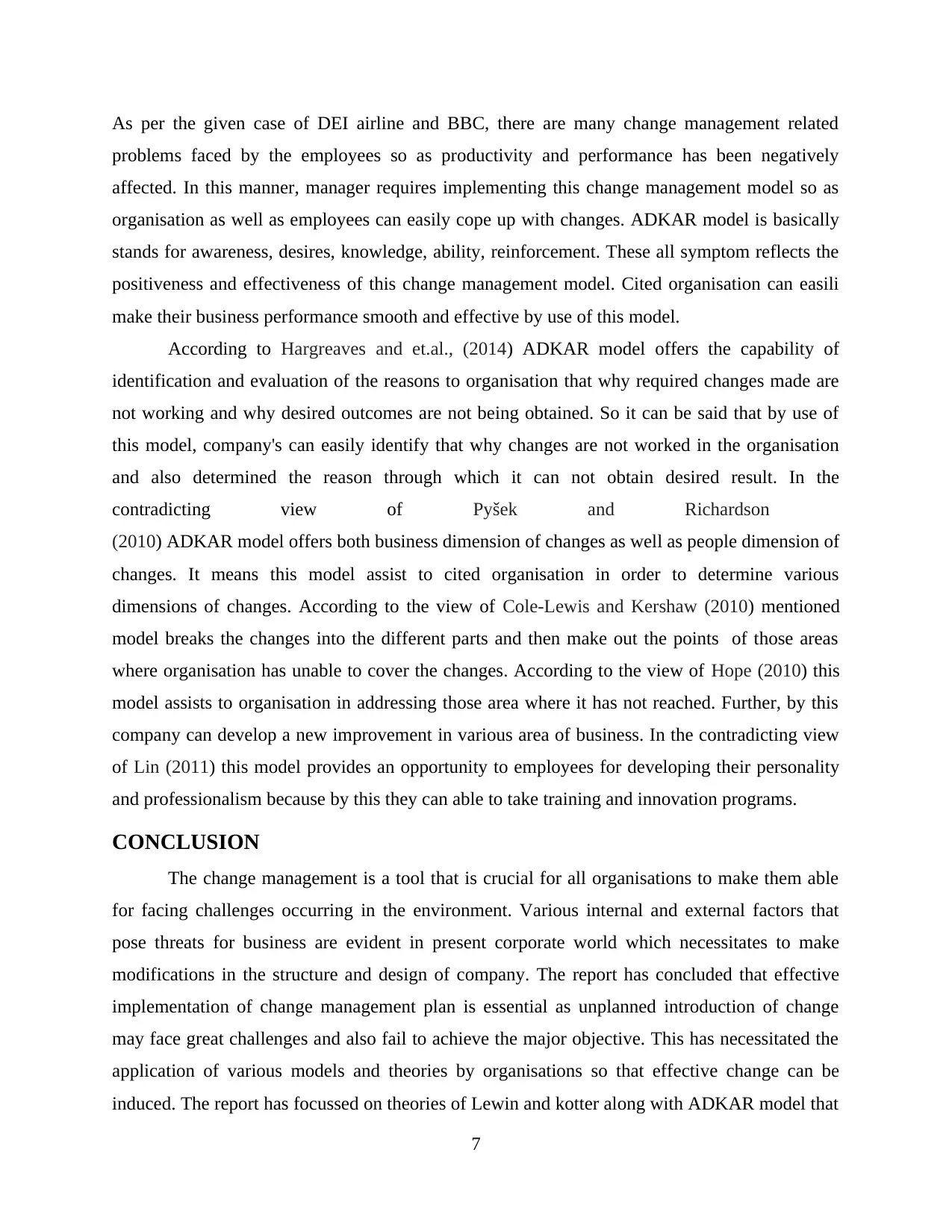
As per the given case of DEI airline and BBC, there are many change management related
problems faced by the employees so as productivity and performance has been negatively
affected. In this manner, manager requires implementing this change management model so as
organisation as well as employees can easily cope up with changes. ADKAR model is basically
stands for awareness, desires, knowledge, ability, reinforcement. These all symptom reflects the
positiveness and effectiveness of this change management model. Cited organisation can easili
make their business performance smooth and effective by use of this model.
According to Hargreaves and et.al., (2014) ADKAR model offers the capability of
identification and evaluation of the reasons to organisation that why required changes made are
not working and why desired outcomes are not being obtained. So it can be said that by use of
this model, company's can easily identify that why changes are not worked in the organisation
and also determined the reason through which it can not obtain desired result. In the
contradicting view of Pyšek and Richardson
(2010) ADKAR model offers both business dimension of changes as well as people dimension of
changes. It means this model assist to cited organisation in order to determine various
dimensions of changes. According to the view of Cole-Lewis and Kershaw (2010) mentioned
model breaks the changes into the different parts and then make out the points of those areas
where organisation has unable to cover the changes. According to the view of Hope (2010) this
model assists to organisation in addressing those area where it has not reached. Further, by this
company can develop a new improvement in various area of business. In the contradicting view
of Lin (2011) this model provides an opportunity to employees for developing their personality
and professionalism because by this they can able to take training and innovation programs.
CONCLUSION
The change management is a tool that is crucial for all organisations to make them able
for facing challenges occurring in the environment. Various internal and external factors that
pose threats for business are evident in present corporate world which necessitates to make
modifications in the structure and design of company. The report has concluded that effective
implementation of change management plan is essential as unplanned introduction of change
may face great challenges and also fail to achieve the major objective. This has necessitated the
application of various models and theories by organisations so that effective change can be
induced. The report has focussed on theories of Lewin and kotter along with ADKAR model that
7
problems faced by the employees so as productivity and performance has been negatively
affected. In this manner, manager requires implementing this change management model so as
organisation as well as employees can easily cope up with changes. ADKAR model is basically
stands for awareness, desires, knowledge, ability, reinforcement. These all symptom reflects the
positiveness and effectiveness of this change management model. Cited organisation can easili
make their business performance smooth and effective by use of this model.
According to Hargreaves and et.al., (2014) ADKAR model offers the capability of
identification and evaluation of the reasons to organisation that why required changes made are
not working and why desired outcomes are not being obtained. So it can be said that by use of
this model, company's can easily identify that why changes are not worked in the organisation
and also determined the reason through which it can not obtain desired result. In the
contradicting view of Pyšek and Richardson
(2010) ADKAR model offers both business dimension of changes as well as people dimension of
changes. It means this model assist to cited organisation in order to determine various
dimensions of changes. According to the view of Cole-Lewis and Kershaw (2010) mentioned
model breaks the changes into the different parts and then make out the points of those areas
where organisation has unable to cover the changes. According to the view of Hope (2010) this
model assists to organisation in addressing those area where it has not reached. Further, by this
company can develop a new improvement in various area of business. In the contradicting view
of Lin (2011) this model provides an opportunity to employees for developing their personality
and professionalism because by this they can able to take training and innovation programs.
CONCLUSION
The change management is a tool that is crucial for all organisations to make them able
for facing challenges occurring in the environment. Various internal and external factors that
pose threats for business are evident in present corporate world which necessitates to make
modifications in the structure and design of company. The report has concluded that effective
implementation of change management plan is essential as unplanned introduction of change
may face great challenges and also fail to achieve the major objective. This has necessitated the
application of various models and theories by organisations so that effective change can be
induced. The report has focussed on theories of Lewin and kotter along with ADKAR model that
7
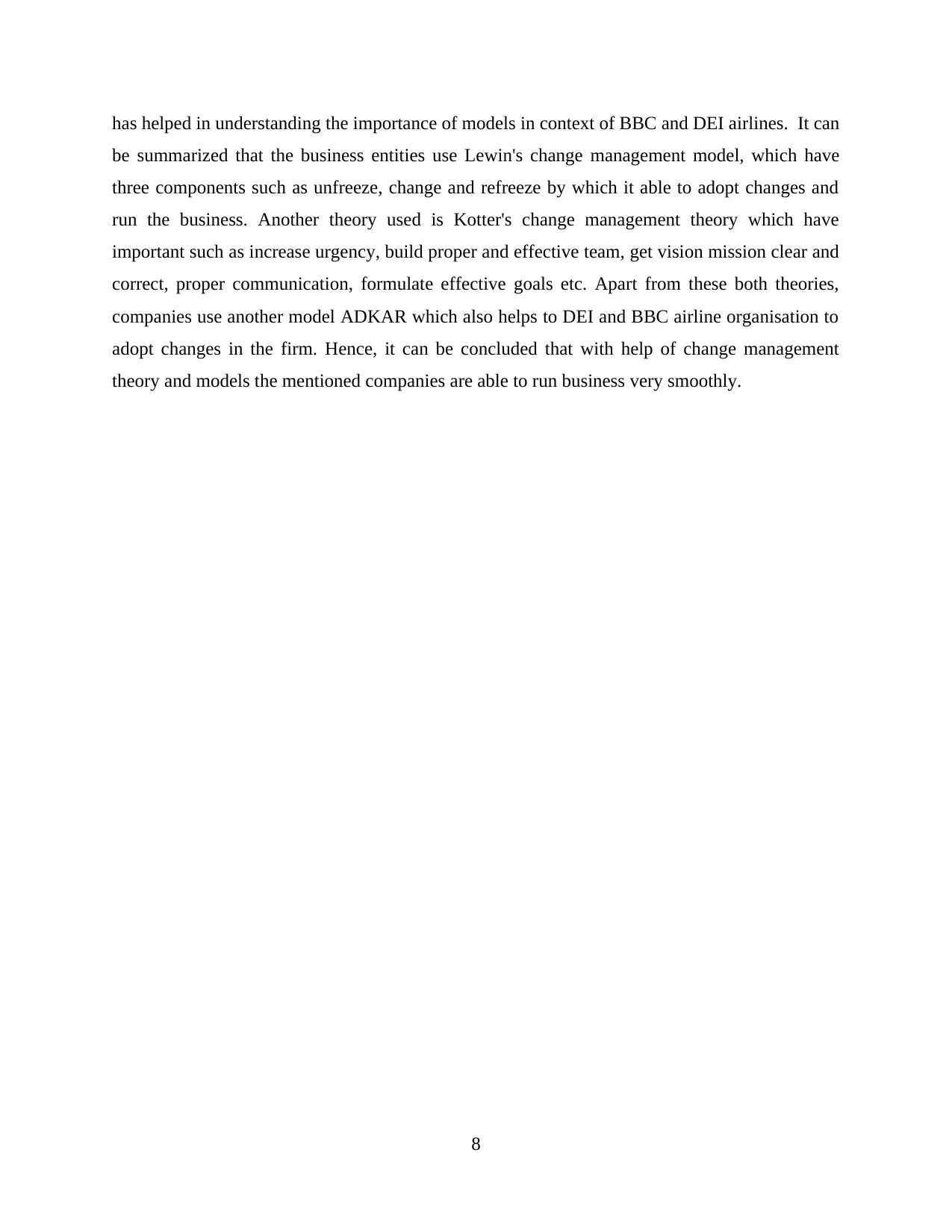
has helped in understanding the importance of models in context of BBC and DEI airlines. It can
be summarized that the business entities use Lewin's change management model, which have
three components such as unfreeze, change and refreeze by which it able to adopt changes and
run the business. Another theory used is Kotter's change management theory which have
important such as increase urgency, build proper and effective team, get vision mission clear and
correct, proper communication, formulate effective goals etc. Apart from these both theories,
companies use another model ADKAR which also helps to DEI and BBC airline organisation to
adopt changes in the firm. Hence, it can be concluded that with help of change management
theory and models the mentioned companies are able to run business very smoothly.
8
be summarized that the business entities use Lewin's change management model, which have
three components such as unfreeze, change and refreeze by which it able to adopt changes and
run the business. Another theory used is Kotter's change management theory which have
important such as increase urgency, build proper and effective team, get vision mission clear and
correct, proper communication, formulate effective goals etc. Apart from these both theories,
companies use another model ADKAR which also helps to DEI and BBC airline organisation to
adopt changes in the firm. Hence, it can be concluded that with help of change management
theory and models the mentioned companies are able to run business very smoothly.
8
⊘ This is a preview!⊘
Do you want full access?
Subscribe today to unlock all pages.

Trusted by 1+ million students worldwide
1 out of 13
Related Documents
Your All-in-One AI-Powered Toolkit for Academic Success.
+13062052269
info@desklib.com
Available 24*7 on WhatsApp / Email
![[object Object]](/_next/static/media/star-bottom.7253800d.svg)
Unlock your academic potential
Copyright © 2020–2025 A2Z Services. All Rights Reserved. Developed and managed by ZUCOL.





